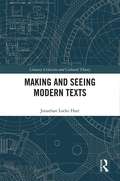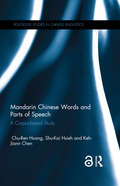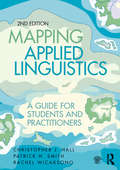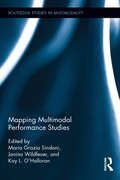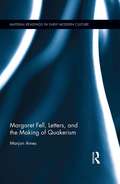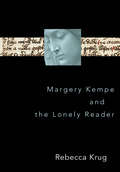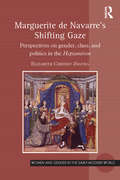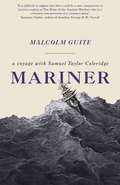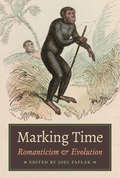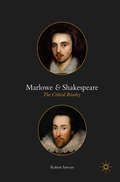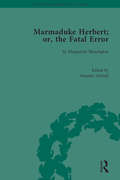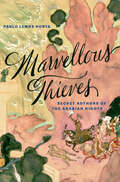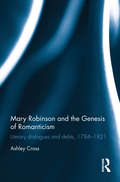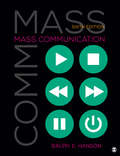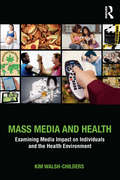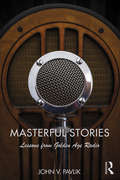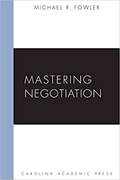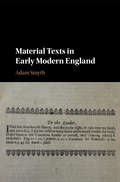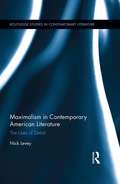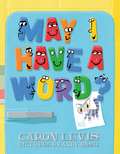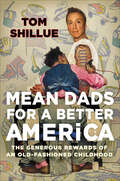- Table View
- List View
Making and Seeing Modern Texts (Literary Criticism and Cultural Theory)
by Jonathan Locke HartMaking and Seeing Modern Texts explores the poetics of texts through a close reading and analysis across the genres of poetry, drama, fiction, non-fiction travel literature and theory. This volume demonstrates that prose, as much as poetry, share the making and seeing of language, literary practice, and theory. Genre, then, is presented as a guide that crosses multiple boundaries. This volume selects different ways to examine texts, discussing Michael Ondaatje’s early poetry and examining narrative in Philip Roth’s The Human Stain. The book examines images in poetry, narrative in fiction, prefaces in non-fiction, metatheatre in drama, and attempts to see the modern and postmodern in theory, all of which show us the complexities of modernity or later modernity. One of the innovations is that the author, a literary critic/theorist, poet and historian, takes his training in practice and theory and shows, through examples of each, how language operates across genres.
Mandarin Chinese Words and Parts of Speech: A Corpus-based Study (Routledge Studies in Chinese Linguistics)
by Chu-Ren Huang Shu-Kai Hsieh Keh-Jiann ChenThis monograph is a translation of two seminal works on corpus-based studies of Mandarin Chinese words and parts of speech. The original books were published as two pioneering technical reports by Chinese Knowledge and Information Processing group (CKIP) at Academia Sinica in 1993 and 1996, respectively. Since then, the standard and PoS tagset proposed in the CKIP report have become the de facto standard in Chinese corpora and computational linguistics, in particular in the context of traditional Chinese texts. This new translation represents and develops the principles and theories originating from these pioneering works. The results can be applied to numerous fields; Chinese syntax and semantics, lexicography, machine translation and other language engineering bound applications. Suitable for graduate and scholars in the fields of linguistics and Chinese, Mandarin Chinese Words and Parts of Speech provides a comprehensive survey of the issues around wordhood and PoS.
Mapping Applied Linguistics: A Guide for Students and Practitioners
by Christopher J. Hall Rachel Wicaksono Patrick H. SmithMapping Applied Linguistics: A guide for students and practitioners, second edition, provides a newly updated, wide-ranging introduction to the full scope of applied linguistics. This innovative book maps the diverse and constantly expanding range of theories, methods and issues faced by students and practitioners around the world, integrating both sociocultural and cognitive perspectives. Practically oriented and ideally suited to students new to the discipline, Mapping Applied Linguistics provides in-depth coverage of: multilingualism, language variation and Global Englishes literacy, language teaching and bilingual education discourse analysis language policy and planning lexicography and translation language pathology and forensic linguistics The new second edition features contemporary examples of global applied linguistics research and practice, and includes updated further reading and new fieldwork suggestions for each chapter. The companion website at cw.routledge.com/textbooks/hall provides a wealth of additional learning material, including activities, flashcards and links to the latest online resources. Mapping Applied Linguistics is essential reading for students studying applied linguistics, TESOL, general linguistics and language and literacy education at the advanced undergraduate or master’s degree level. It also provides a gateway for practitioners and specialists seeking to better understand the wider scope of their work.
Mapping Multimodal Performance Studies (Routledge Studies in Multimodality)
by Kay O'Halloran Janina Wildfeuer Maria Grazia SindoniThis book is a first attempt to map the broad context of performance studies from a multimodal perspective. It collects original research on traditional performing arts (theatre, dance, opera), live (durational performance) and mediated/recorded performances (films, television shows), as well as performative discursive practices on social media by adopting several theories and methodologies all dealing with the notion of multimodality. As a mostly dynamic and also interactive environment for various text types and genres, the context of performance studies provides many opportunities to produce meaning verbally and non-verbally. All chapters in this book develop frameworks for the analysis of performance-related events and activities and explore empirical case studies in a range of different ages and cultures. A further focus lies on the communicative strategies deployed by different communities of practice, taking into account processes of production, distribution, and consumption of such texts in diverse spatial and temporal contexts.
Margaret Fell, Letters, and the Making of Quakerism (Material Readings in Early Modern Culture)
by Marjon AmesIntensely persecuted during the English Interregnum, early Quakers left a detailed record of the suffering they endured for their faith. Margaret Fell, Letters, and the Making of Quakerism is the first book to connect the suffering experience with the communication network that drew the faithful together to create a new religious community. This study explores the ways in which early Quaker leaders, particularly Margaret Fell, helped shape a stable organization that allowed for the transition from movement to church to occur. Fell’s role was essential to this process because she developed and maintained the epistolary exchange that was the basis of the early religious community. Her efforts allowed for others to travel and spread the faith while she served as nucleus of the community’s communication network by determining how and where to share news. Memory of the early years of Quakerism were based on the letters Fell preserved. Marjon Ames analyzes not only how Fell’s efforts shaped the inchoate faith, but also how subsequent generations memorialized their founding members.
Margery Kempe and the Lonely Reader
by Rebecca KrugSince its rediscovery in 1934, the fifteenth-century Book of Margery Kempe has become a canonical text for students of medieval Christian mysticism and spirituality. Its author was a fifteenth-century English laywoman who, after the birth of her first child, experienced vivid religious visions and vowed to lead a deeply religious life while remaining part of the secular world. After twenty years, Kempe began to compose with the help of scribes a book of consolation, a type of devotional writing found in late medieval religious culture that taught readers how to find spiritual comfort and how to feel about one's spiritual life. In Margery Kempe and the Lonely Reader, Rebecca Krug shows how and why Kempe wrote her Book, arguing that in her engagement with written culture she discovered a desire to experience spiritual comfort and to interact with fellow believers who also sought to live lives of intense emotional engagement.An unlikely candidate for authorship in the late medieval period given her gender and lack of formal education, Kempe wrote her Book as a revisionary act. Krug shows how the Book reinterprets concepts from late medieval devotional writing (comfort, despair, shame, fear, and loneliness) in its search to create a spiritual community that reaches out to and includes Kempe, her friends, family, advisers, and potential readers. Krug offers a fresh analysis of the Book as a written work and draws attention to the importance of reading, revision, and collaboration for understanding both Kempe’s particular decision to write and the social conditions of late medieval women’s authorship.
Marguerite de Navarre's Shifting Gaze: Perspectives on gender, class, and politics in the Heptaméron (Women and Gender in the Early Modern World)
by Elizabeth Chesney ZeguraMarguerite de Navarre’s Heptaméron, composed in the 1540s and first published posthumously in 1558 and 1559, has long been an interpretive puzzle. De Navarre (1492-1549), sister of King Francis I of France, was a controversial figure in her lifetime. Her evangelical activities and proximity to the Crown placed her at the epicenter of her country’s internecine strife and societal unrest. Yet her short stories appear to offer few traces of the sociopolitical turbulence that surrounded her.In Marguerite de Navarre’s Shifting Gaze, however, Elizabeth Zegura argues that the Heptaméron’s innocuous appearance camouflages its serious insights into patriarchy and gender, social class, and early modern French politics, which emerge from an analysis of the text’s shifting perspectives. Zegura’s approach, which focuses on visual cues and alternative standpoints and viewing positions within the text, hinges upon foregrounding "les choses basses" (lowly things) to which the devisante (storyteller) Oisille draws our attention in nouvelle (novella) 2 of the Heptaméron, using this downward, archaeological gaze to excavate layers of the text that merit more extensive critical attention.While her conclusions cast a new light on the literature, life, and times of Marguerite de Navarre, they are nevertheless closely aligned with recent scholarship on this important historical and literary figure.
Mariner: A Voyage with Samuel Taylor Coleridge
by Reverend Dr Malcolm Guite'The story of Coleridge's life does undoubtedly echo that of his poem; this is a book that provides rewarding rereadings of both' - The Sunday TimesA new biography of Samuel Taylor Coleridge, shaped and structured around the story he himself tells in his most famous poem, 'The Rime of the Ancient Mariner'. Though the 'Mariner' was written in 1797 when Coleridge was only twenty-five, it was an astonishingly prescient poem. As Coleridge himself came to realise much later, this tale - of a journey that starts in high hopes and good spirits, but leads to a profound encounter with human fallibility, darkness, alienation, loneliness and dread, before coming home to a renewal of faith and vocation - was to be the shape of his own life. In this rich new biography, academic, priest and poet Malcolm Guite draws out how with an uncanny clarity, image after image and event after event in the poem became emblems of what Coleridge was later to suffer and discover. Of course 'The Rime of the Ancient Mariner' is more than just an individual's story: it is also a profound exploration of the human condition and, as Coleridge says in his gloss, our 'loneliness and fixedness'. But the poem also offers hope, release, and recovery; and Guite also draws out the continuing relevance of Coleridge's life and writing to our own time.'Forcefully and convincingly argued' - The Telegraph
Mariner: A Voyage with Samuel Taylor Coleridge
by Reverend Dr Malcolm Guite'The story of Coleridge's life does undoubtedly echo that of his poem; this is a book that provides rewarding rereadings of both' - The Sunday TimesA new biography of Samuel Taylor Coleridge, shaped and structured around the story he himself tells in his most famous poem, 'The Rime of the Ancient Mariner'. Though the 'Mariner' was written in 1797 when Coleridge was only twenty-five, it was an astonishingly prescient poem. As Coleridge himself came to realise much later, this tale - of a journey that starts in high hopes and good spirits, but leads to a profound encounter with human fallibility, darkness, alienation, loneliness and dread, before coming home to a renewal of faith and vocation - was to be the shape of his own life. In this rich new biography, academic, priest and poet Malcolm Guite draws out how with an uncanny clarity, image after image and event after event in the poem became emblems of what Coleridge was later to suffer and discover. Of course 'The Rime of the Ancient Mariner' is more than just an individual's story: it is also a profound exploration of the human condition and, as Coleridge says in his gloss, our 'loneliness and fixedness'. But the poem also offers hope, release, and recovery; and Guite also draws out the continuing relevance of Coleridge's life and writing to our own time.'Forcefully and convincingly argued' - The Telegraph
Marking Time: Romanticism and Evolution
by Joel FaflakScholars have long studied the impact of Charles Darwin’s writings on nineteenth-century culture. However, few have ventured to examine the precursors to the ideas of Darwin and others in the Romantic period. Marking Time, edited by Joel Faflak, analyses prevailing notions of evolution by tracing its origins to the literary, scientific, and philosophical discourses of the long nineteenth century. The volume’s contributors revisit key developments in the history of evolution prior to The Origin of Species and explore British and European Romanticism’s negotiation between the classic idea of a great immutable chain of being and modern notions of historical change. Marking Time reveals how Romantic and post-Romantic configurations of historical, socio-cultural, scientific, and philosophical transformation continue to exert a profound influence on critical and cultural thought.
Marlowe and Shakespeare
by Robert SawyerInstead of asserting any alleged rivalry between Marlowe and Shakespeare, Sawyer examines the literary reception of the two when the writers are placed in tandem during critical discourse or artistic production. Focusing on specific examples from the last 400 years, the study begins with Robert Greene's comments in 1592 and ends with the post-9/11 and 7/7 era. The study not only looks at literary critics and their assessments, but also at playwrights such as Aphra Behn, novelists such as Anthony Burgess, and late twentieth-century movie and theatre directors. The work concludes by showing how the most recent outbreak of Marlowe as Shakespeare's ghostwriter accelerates due to a climate of conspiracy, including "belief echoes," which presently permeate our cultural and critical discourse.
Marmaduke Herbert; or, the Fatal Error: by Marguerite Blessington (Chawton House Library: Women's Novels)
by Susanne SchmidIn the early and mid-nineteenth century, Marguerite Blessington, who had been born in Ireland but spent most of her life in London, became a famous salonnière; she was generally regarded as an important contemporary author, but as no literary executor took care of her oeuvre posthumously, she eventually moved into the background. Her novels, partly informed by the silver-fork genre, are typical examples of Romantic Victorianism, influenced by the Romantic cult of the solitary male self, by the fascination with Italy, and by the 1840s vogue of crime fiction, while simultaneously giving space to ambivalent reflections about Blessington’s own Irish background. This volume, as part of ‘Chawton House Library: Women’s Novels’ series, presents her 1847 novel Marmaduke Herbert; or, the Fatal Error, a highly popular piece of fiction in its day, being reprinted in German, French and American editions within a year of its publication.
Marvellous Thieves: Secret Authors of the Arabian Nights
by Paulo Lemos HortaRanging from the coffeehouses of Aleppo to the salons of Paris, from Calcutta to London, Paulo Lemos Horta introduces the poets and scholars, pilgrims and charlatans who made largely unacknowledged contributions to Arabian Nights. Each version betrays the distinctive cultural milieu in which it was produced.
Mary Robinson and the Genesis of Romanticism: Literary Dialogues and Debts, 1784–1821
by Ashley CrossFirst coming to prominence as an actress and scandalous celebrity, Mary Robinson created an identity for herself as a Romantic poet and novelist in the 1790s. Through a series of literary dialogues with established writers, Robinson put herself at the center of Romantic literary culture as observer, participant, and creator. Cross argues that Robinson’s dialogues shaped the nature of Romantic writing both in content and form and influenced second-generation Romantics. These dialogues further establish the idea of Romantic discourse as essentially interactive and conversational, not the work of original geniuses working in isolation, and positions Robinson as a central player in its genesis.
Mary Robinson and the Genesis of Romanticism: Literary Dialogues and Debts, 1784–1821
by Ashley CrossFirst coming to prominence as an actress and scandalous celebrity, Mary Robinson created an identity for herself as a Romantic poet and novelist in the 1790s. Through a series of literary dialogues with established writers, Robinson put herself at the center of Romantic literary culture as observer, participant, and creator. Cross argues that Robinson’s dialogues shaped the nature of Romantic writing both in content and form and influenced second-generation Romantics. These dialogues further establish the idea of Romantic discourse as essentially interactive and conversational, not the work of original geniuses working in isolation, and positions Robinson as a central player in its genesis.
Mass Communication: Living in a Media World
by Ralph E. HansonTransform your students into smart, savvy consumers of the media. Mass Communication: Living in a Media World (Ralph E. Hanson) provides students with comprehensive yet concise coverage of all aspects of mass media, along with insightful analysis, robust pedagogy, and fun, conversational writing. In every chapter of this bestselling text, students will explore the latest developments and current events that are rapidly changing the media landscape. This newly revised Sixth Edition is packed with contemporary examples, engaging infographics, and compelling stories about the ways mass media shape our lives. From start to finish, students will learn the media literacy principles and critical thinking skills they need to become savvy media consumers.
Mass Communication: Living in a Media World
by Ralph E. HansonTransform your students into smart, savvy consumers of the media. Mass Communication: Living in a Media World (Ralph E. Hanson) provides students with comprehensive yet concise coverage of all aspects of mass media, along with insightful analysis, robust pedagogy, and fun, conversational writing. In every chapter of this bestselling text, students will explore the latest developments and current events that are rapidly changing the media landscape. This newly revised Sixth Edition is packed with contemporary examples, engaging infographics, and compelling stories about the ways mass media shape our lives. From start to finish, students will learn the media literacy principles and critical thinking skills they need to become savvy media consumers.
Mass Media and Health: Examining Media Impact on Individuals and the Health Environment
by Kim Walsh-ChildersMass Media and Health: Examining Media Impact on Individuals and the Health Environment covers media health influences from a variety of angles, including the impact on individual and public health, the intentionality of these effects, and the nature of the outcomes. Author Kim Walsh-Childers helps readers understand the influence that mass media has on an individual’s health beliefs and, in turn, their behaviors. She explains how public health policy can be affected, altering the environment in which a community’s members make choices, and discusses the unintentional health effects of mass media, examining them through the strategic lens of news framing and advocacy campaigns. Written for students across a variety of disciplines, Mass Media and Health will serve as primary reading for courses examining the broader view of mass media and health impacts, as well as providing supplemental reading for courses on health communication, public health campaigns, health journalism, and media effects.
Masterful Stories: Lessons from Golden Age Radio
by John V PavlikThe early eras of radio storytelling have entered and continue to enter the public domain in large quantities, offering unprecedented access to the Golden Age of Radio. Author and Professor John Pavlik mines the best this age of radio has to offer in Masterful Stories, an examination of the masterpieces of audio storytelling. This book provides a chronological history of the best of the best from radio’s Golden Age, outlining a core set of principles and techniques that made these radio plays enduring examples of storytelling. It suggests that, by using these techniques, stories can engage audiences emotionally and intellectually. Grounded in a historical and theoretical understanding of radio drama, this volume illuminates the foundational works that proceeded popular modern shows such as Radiolab, The Moth, and Serial. Masterful Stories will be a powerful resource in both media history courses and courses teaching audio storytelling for modern radio and other audio formats, such as podcasting. It will appeal to audio fans looking to learn about and understand the early days of radio drama.
Mastering Negotiation
by Michael R. FowlerThis comprehensive book covers the key stages of the negotiation process: choosing an approach, preparing to negotiate, initiating talks, moving to substantive bargaining and problem-solving, overcoming common difficulties, and closing a deal. It focuses on issues of negotiation strategy, especially those associated with the interest-based or mutual-gains negotiation that professional negotiators often use in complex disputes. Special features include chapters on cross-cultural negotiations, group negotiations, and ethical issues.
Material Texts in Early Modern England
by Adam SmythWhat was a book in early modern England? By combining book history, bibliography and literary criticism, Material Texts in Early Modern England explores how sixteenth- and seventeenth-century books were stranger, richer things than scholars have imagined. Adam Smyth examines important aspects of bibliographical culture which have been under-examined by critics: the cutting up of books as a form of careful reading; book destruction and its relation to canon formation; the prevalence of printed errors and the literary richness of mistakes; and the recycling of older texts in the bodies of new books, as printed waste. How did authors, including Herbert, Jonson, Milton, Nashe and Cavendish, respond to this sense of the book as patched, transient, flawed, and palimpsestic? Material Texts in Early Modern England recovers these traits and practices, and so crucially revises our sense of what a book was, and what a book might be.
Maximalism in Contemporary American Literature: The Uses of Detail (Routledge Studies in Contemporary Literature)
by Nick LeveyThis book begins a new and foundational discussion of maximalism by investigating how the treatment of detail in contemporary literature impels readers to navigate, tolerate, and enrich the cultural landscape of postindustrial America. It studies the maximalist novels of David Foster Wallace, Nicholson Baker, Thomas Pynchon, and others, considering how overly-detailed writing serves the institutional, emotional, and intellectual needs of contemporary readers and writers. The book argues that maximalist novels not only exceed perceived limits of style, subject matter, and scope, but strive to remake the usefulness of books in contemporary culture, refreshing the act of reading. Levey shows that while these novels are preoccupied with detail and description, they are relatively unconcerned with the traditional goals of representation. Instead, they use detail to communicate particular values and fantasies of intelligence, enthusiasm, and ability attached to the management of complex and excessive information. Whether reinvigorating the banal and trivial in mainstream culture, or soothing anxieties of human insufficiency in the age of automation and the internet, these texts model significant abilities, rather than just objects of significance, and encourage readers to develop habits of reading that complement the demands of an increasingly detailed culture. Drawing upon a diverse range of theoretical schools and cultural texts, including Thing Theory, Marxism, New Formalism, playlists, blogs, and archival manuscripts, the book proposes a new understanding of maximalist writing and a new way of approaching the usefulness of literary objects in contemporary culture.
May I Have a Word?
by Caron LevisA battle of the magnet letters ensues across the refrigerator door in May I Have a Word? when C and K get into a fight about who gets to start the cooler (kooler?) words. When the two letters storm off in opposite directions, everything is turned upside down. SOCKS are now SO, there aren't any CLOCKS to TICK or TOCK, and the world is just out of LUCK--until other letters work to bring C and K back together again.
Mean Dads for a Better America: The Generous Rewards of an Old-Fashioned Childhood
by Tom ShillueAs a comedian and conservative thinker, whip-smart funny Tom Shillue grounds his ideas about our current culture and political climate in stories from his childhood — a portrait of growing up in 1970s America. Growing up as one of five kids in a devout Irish Catholic family in a small town outside of Boston, Tom sincerely believes that the rough-and-tumble, rules-dominated world in which he came of age was a better America—a time and place that made him into the well-adjusted, happy, successful man he is today. In Mean Dads for a Better America, Tom reminisces about his childhood, his family, and the traditional values he cherishes. He takes us back to a time when neighbors disciplined each other’s children without fear of being sued, when kids made it to the family table for dinner, when parents’ rules were gospel, when the occasional fistfight was considered a fair way to solve a problem, and when children were free to roam, make mistakes, and experience the first tastes of independence. Tom debates, debunks, and entertains with his hilarious approach to issues of the day, tackling the issues that confound many Americans, like our hypersensitive culture and overzealous parenting. As Tom celebrates the stability of family life and the sanity of days gone by, he encourages us to hold on to our sense of humor and look back at our own lives, as we work towards creating a better future for ourselves and our kids, all while making us laugh.
Measured Words: Computation and Writing in Renaissance Italy
by Arielle SaiberMeasured Words investigates the rich commerce between computation and writing that proliferated in fifteenth- and sixteenth-century Italy. Arielle Saiber explores the relationship between number, shape, and the written word in the works of four exceptional thinkers: Leon Battista Alberti’s treatis on cryptography, Luca Pacioli’s ideal proportions for designing Roman capital letters, Niccolò Tartaglia’s poem embedding his solution to solving cubic equations, and Giambattista Della Porta’s curious study on the elements of geometric curves. Although they came from different social classes and practiced the mathematical and literary arts at differing levels of sophistication, they were all guided by a sense that there exist deep ontological and epistemological bonds between computational and verbal thinking and production. Their shared view that a network or continuity exists between the arts yielded extraordinary results. Through measuring their words, literally and figuratively, they are models of what the very best interdisciplinary work can offer us.
